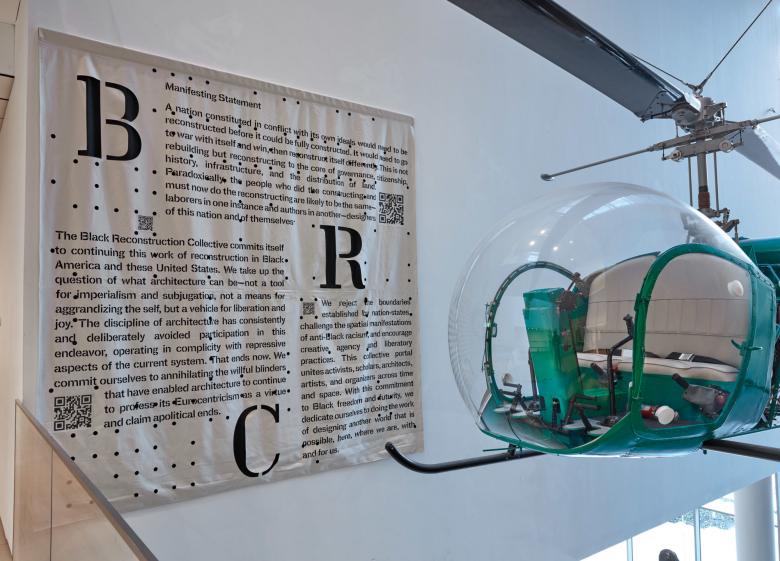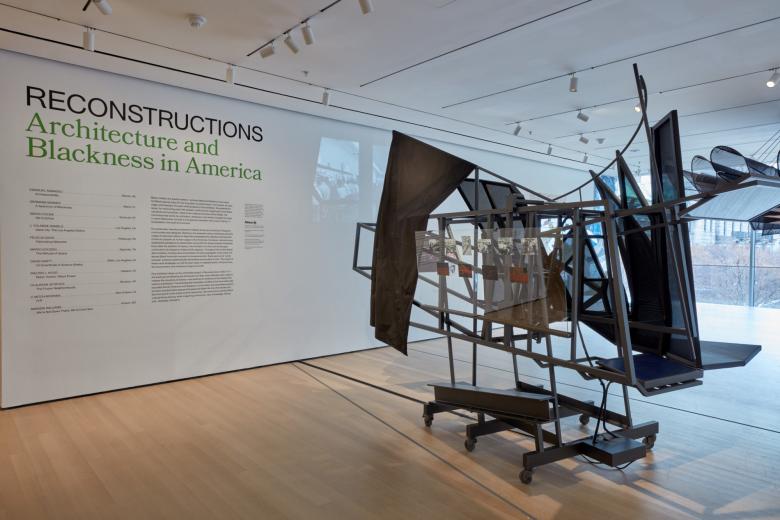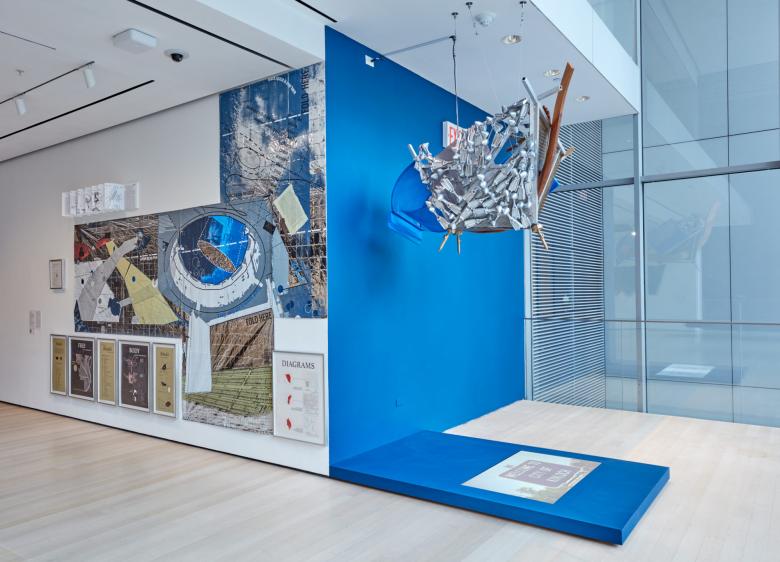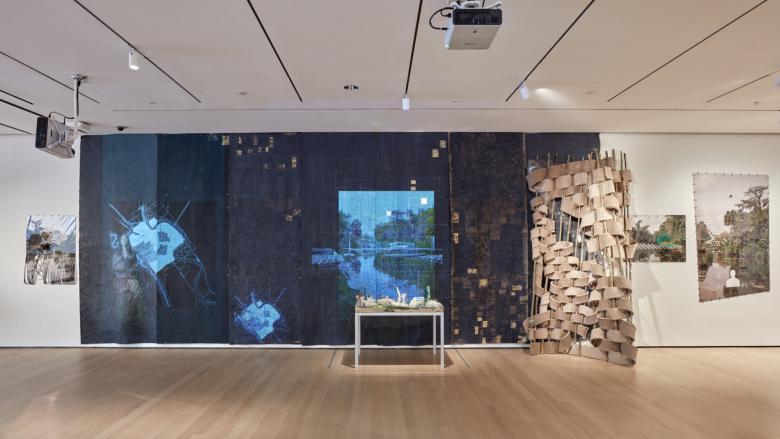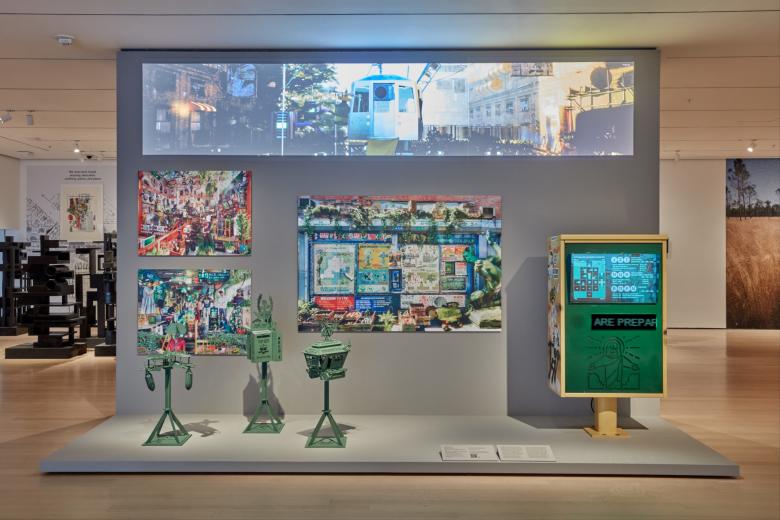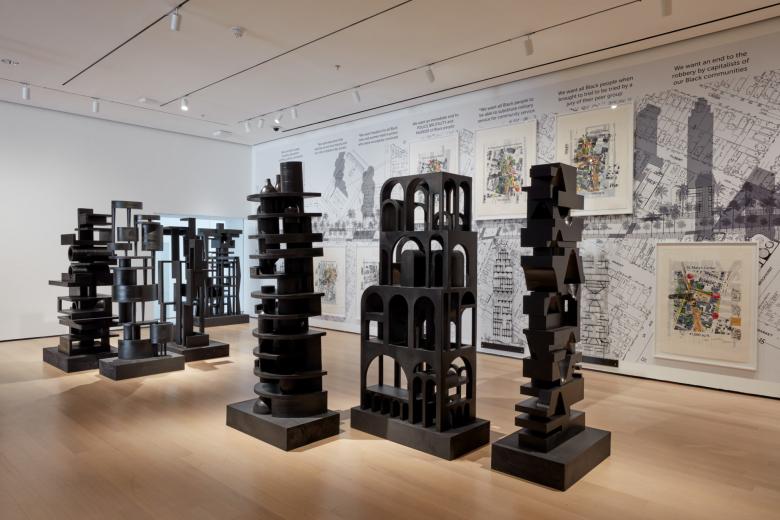The Tools of 'Reconstructions'
Reconstructions: Architecture and Blackness in America opened in late February at the Museum of Modern Art (MoMA) in New York City. Curated by MoMA's Sean Anderson and Columbia University's Mabel O. Wilson, the exhibition explores "how people have mobilized Black cultural spaces, forms, and practices as sites of imagination, liberation, resistance, and refusal."
Before entering the third-floor galleries that house Reconstructions: Architecture and Blackness in America, visitors confront the "manifesting statement" of the Black Reconstruction Collective, authored by ten of the eleven contributors to the exhibition. The text professes, among other things, that the discipline of architecture can no longer be silent or take an apolitical stance in regards to anti-Black racism; many artists are outspoken in condemning racist actions and policies and demanding justice, but architects have remained predominantly quiet. It is a strong statement (it can be read here), but it's location — hung on the wall next to a Bell-47D1 Helicopter suspended over the lobby — is a bit odd, uncomfortable even, as if it isn't being given enough space.
This location, it turns out, is intentional, as the textile covers up the signage for the galleries named for the late architect Philip Johnson: founder of the Architecture & Design Department at MoMA, longtime curator and trustee at the museum, and Nazi sympathizer who embraced fascism at home and in Germany in the 1930s. MoMA would not remove Johnson's name from the gallery following protests that started late last year, so the BRC covered it — a temporary compromise. In addition to outlining the goals of the exhibition participants, the manifesto implicates the institution in the racism they are addressing and foregrounds the importance of space and visibility in forming Black communities.
Visitors who take the elevators to the third floor enter Reconstructions in a different place and are therefore greeted with an image much different than the manifesto: a large map of the contiguous United States drawn on the wall. Free of state boundaries, the map locates roughly 75 "All Black Towns" that were created after the Civil War as "defensive communities," per the wall text, "intended to protect their residents against the ravages of racist Jim Crow laws." Ten of the places are highlighted as the settings for the contributions by the eleven architects, designers, and artists who were commissioned in this fourth installment of MoMA's intermittent "Issues in Contemporary Architecture" series. (It was preceded by: Uneven Growth: Tactical Urbanisms for Expanding Megacities, 2014/2015; Foreclosed: Rehousing the American Dream, 2012; and Rising Currents: Projects for New York’s Waterfront, 2010.) Moving east to west across the United States, the places/creators/projects are:
- Brooklyn, NY: Olalekan Jeyifous, The Frozen Neighborhoods
- Syracuse, NY: Sekou Cooke, We Outchea
- Pittsburgh, PA: Felicia Davis, Fabricating Networks
- Miami, FL: Germane Barnes, A Spectrum of Blackness
- Atlanta, GA: Emanuel Admassu, Immeasurability
- Nashville, TN: Mario Gooden, The Refusal of Space
- Kinloch, MO: Amanda Williams, We’re Not Down There, We’re Over Here
- New Orleans, LA: V. Mitch McEwen, R:R
- Los Angeles, CA: J. Yolande Daniels, Black City: The Los Angeles Edition; David Hartt, On Exactitude in Science (Watts)
- Oakland, CA: Walter J. Hood, Black Towers / Black Power
One of these places stood out on my visit, in part because it is not as familiar a name as the rest, but also for its deplorable history. I learned about Kinloch, Missouri, four years ago, after flying into St. Louis Lambert International Airport and seeing, at the western end of one of the runways, a strange sight: a network of residential streets that had trees but no houses. That area was Carrollton, a primarily white neighborhood obliterated by a runway expansion: around 2,000 homes and numerous business, schools, and churches were demolished between 2000 and 2009 via eminent domain. The runway — a white elephant, as it is rarely, if ever, used — covers most of Carrollton, but traces remain in the old curving streets still visible in aerial views.
Decades earlier, a similar displacement occurred in the Black community of Kinloch, directly east of Lambert International and opposite its other runway. There most of the town's residents were evicted after the City of St. Louis and the airport, starting in the 1980s, bought up about 75% of the community's land in response to a federal aviation noise-abatement program. The population plummeted from a peak of more than 10,000 residents beforehand to around just 300 in 2010. Formally incorporated in 1948, Kinloch is notable as the oldest African-American community to be incorporated in Missouri, but its roots extend back to the 1890s. Today, with just a few houses and other buildings clustered along some of its streets, Kinloch is clearly a shell of its former self but it is also a fitting example of how the post-Reconstruction era in the United States has disenfranchised Black communities.
Kinloch is the setting for the contribution by Amanda Williams, a visual artist whose work I first saw at the 2015 Chicago Architecture Biennial and then at the US Pavilion during the 2018 Venice Architecture Biennale. Her piece in Reconstructions is titled We’re Not Down There, We’re Over Here and is comprised of two parts: an unfolded mylar rescue blanket, patents, and diagrams mounted on one wall; and a sculpture and video around the corner. Williams sees Kinloch, like outer space, as a frontier and therefore uses it as a "launching" site for her artwork that incorporates products invented and patented by African Americans. Ice cream scoops and sprinkler nozzles, suspended above the short video, become expressions of how "everyone has a right to participate in making America the place they wanted it to be." The blanket is her own invention, a "spaceboatshipvesselcapsule" that would help Black people "navigate their way to free Black space" such as Kinloch.
The artist's audio commentary for We’re Not Down There, We’re Over Here ponders what places like Kinloch would be like if they thrived — if they were allowed to thrive. Another contribution goes further and imagines what New Orleans would look like if an early 19th-century slave rebellion there had been successful. Architectural designer V. Mitch McEwen's R:R envisions Republica, "a quasi-fictional city centered on Blackness" based on artist Kristina Kay Robinson's performance art project of the same name. Literary historian Autumn Womack, another collaborator on R:R, asks in the companion publication to Reconstructions, "What would a Black space look like ... when the materiality is not tied to extraction?," referring to the energy industry around New Orleans. For McEwen, it is bamboo, concrete, and textiles in a system based on weaving, and expressed in models, collages, and an animated figure narrating her vision of Republica. As such, R:R resembles an architectural project — a potential form for a hypothetical future — more than a number of the other works commissioned for the exhibition.
Generally, the contributions to Reconstructions fall somewhere between the poles of Williams's artistic history lesson and McEwen's architectural speculation. A couple more examples: Artist Olalekan Jeyifous's The Frozen Neighborhoods expresses a fictional future for Crown Heights, Brooklyn, where technology has made it difficult for Black residents to leave the neighborhood but has sparked them to "create sustainable practices and new technologies to serve their own needs." Landscape architect Walter J. Hood's Black Towers/Block Power consists of clearly architectural designs for a series of towers for a one-mile stretch of San Pablo Avenue in Oakland. Put another way, although the earlier Uneven Growth, Foreclosed, and Rising Currents exhibitions in the "Issues in Contemporary Architecture" series consisted of projects that were clearly architectural and were therefore easy to see scaled up as buildings or landscapes to some degree, on the whole Reconstructions is more interested in sparking new ways of thinking and imagining. Each project can be thought of as a separate tool for building new futures: "of designing another world," in the words of the Black Reconstruction Collective, "that is possible, here, where we are, with and for us."
